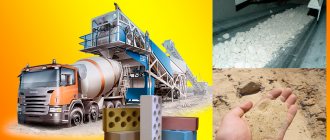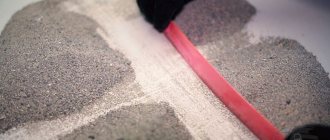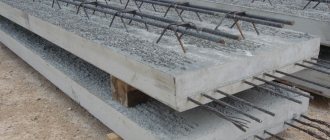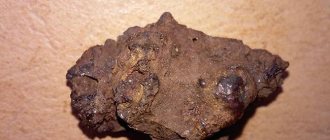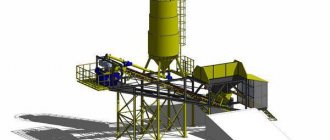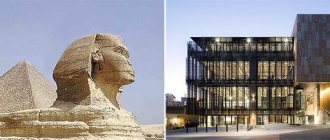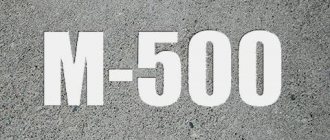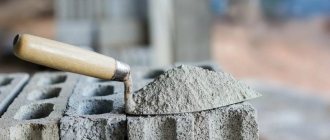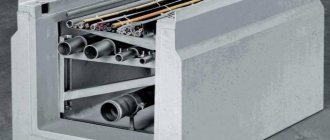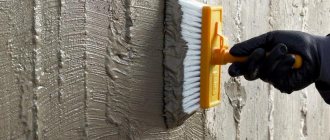Concrete is one of the most durable materials used in construction. Due to its characteristics, it is able to last for a long period of time. Experts note that this solution has one drawback that affects its popularity - concrete has an unaesthetic appearance. For this reason, after using it, you have to spend money and time on additional finishing.
However, the development of technological progress has made it possible to create a new type of material - transparent concrete. Objects created using such a mixture are able to transmit some of the rays of artificial or natural light. The new approach has expanded the scope of application of transparent concrete. Production technology makes it possible for anyone to create it themselves. To do this, you need to know the main characteristics and areas of application.
What is light-conducting concrete?
Light-conducting concrete was first patented by a Hungarian specialist. After that, he gained popularity all over the world. The main idea was to create a building material that could meet all quality standards and let additional light into the room. At the same time, the strength had to remain at the same level. After numerous attempts, a new type of concrete entered the market - Litracon (translucent concrete).
Transparency properties were achieved by improving the composition. Large fillers were removed from it and thin threads capable of conducting light were added.
In addition, the composition included:
- fiberglass;
- fine-grained composite materials;
- Portland cement;
- sand;
- water;
- plasticizers.
The market offers mixtures of classic and non-standard shades: gray, black, red, etc.
It is worth clarifying that concrete itself is not transparent. Due to the quartz optical fiber, it is able to conduct light rays through itself, which is why the transparency effect appears.
When light hits the end of the block, it is reflected and refracted in some places, after which it passes through and comes out on the other side. As a result, a pattern is formed indicating that the level of light transmittance depends not on the thickness of the concrete product, but on the density of the threads. Thus, the higher this indicator, the more light passes through the object.
If there is no light source, then the appearance of such concrete is no different from the standard one. The property of transparency appears only during daylight hours or when lamps or other lighting devices are turned on.
Does it make sense to make transparent concrete yourself?
Transparent concrete (light-conducting concrete) in structure consists of fine-grained high-strength concrete and light fibers arranged in a certain order.
Content
- Application of transparent concrete.
- The history of the creation of transparent concrete.
- A little about fiber optics.
- DIY transparent concrete.
Price
Transparent concrete has the only negative side - the price. The new technology used to create the mixture and the materials used are expensive. Depending on the manufacturer, the cost of clear concrete can vary greatly.
This price is explained by another factor - the low demand for products from the mixture. Construction and architectural firms rarely use such material in their work. Therefore, there are not many enterprises producing transparent concrete. They are mainly concentrated abroad. This gives rise to another expense item that affects the cost of goods – transportation.
A square meter of an average-sized slab can cost about 90 thousand rubles.
General information
Transparent or light-conducting concrete (Litracon) was invented in 2001 by a Hungarian architect. The fine-grained structure of this material includes fiber-optic glass threads. As a result, the material is a durable substance permeated with thin glass fibers.
It should be noted right away that the price of transparent concrete is very high, which is due to the technological complexity of its production. Therefore, it is produced exclusively to order in the form of rectangular panels, the dimensions of which are selected in accordance with the wishes of the customer.
Initially, it was possible to purchase light-conducting concrete only abroad, as a result of which delivery costs were added to the high price of the material. However, recently domestic manufacturers have also started producing it. Moreover, they began to offer this material at much more favorable prices.
Block of transparent concrete
Properties
Experts have developed the composition of translucent concrete in such a way that it has many useful properties:
- increased strength;
- sound insulation;
- high percentage of thermal insulation;
- water resistance.
Fiberglass, which was added to the composition of the improved concrete, gave the mixture a number of other characteristics:
- 6% moisture absorption level;
- increased throughput (up to 2 meters);
- good tolerance to exposure to low temperatures and ultraviolet rays;
- strength during bending and compression.
Litracon is suitable for the construction of environmentally friendly buildings. The composition includes only natural ingredients. This is confirmed by the presence of many certificates.
Transparent concrete adheres well to any surface. For this, mortars, glue mixtures, anchors, etc. are used.
Depending on the brand of concrete, the type of treatment may differ. This is how panels are produced in matte and glossy (polished) appearance.
To protect products from moisture, before use the surface is treated with protective compounds, impregnations or varnishes. As a result, the service life increases.
Purpose
Concrete is considered a boring material and is usually used for menial work. To make it sparkle with new colors, a new technique for making concrete blocks was developed.
Light-transmitting concrete or “Litracon” - thanks to its new properties, the material has begun to be actively used as decoration, for finishing buildings, partitions in rooms, and even for decorating lamps.
Hungarian architect Aron Losonczy experimented for a long time before he finally came up with transparent concrete. What does the new material consist of:
- cement;
- fine sand;
- fiber optic fibers;
- specialized additives for better formability.
Scope of application
Transparent concrete is purchased only if it is necessary to give the object a decorative appearance.
To make the effect of such panels even better, LED strips are installed in special openings. They help emphasize the advantage of Litracon compared to other materials.
The scope of use of concrete is the creation of:
- interior objects (lamps);
- furniture (tabletops, benches, chairs);
- niches or partitions;
- plumbing equipment;
- design of wall panels, etc.
Thus, in public institutions you can often find bar counters, glowing tabletops or reception desks made of transparent concrete.
To make the interior unusual, it is used to fill the floors, while providing illumination. The material is popular in the design of city streets. Lanterns, fountains, and signs are made from it.
During construction work, buildings or individual facades can be erected from it.
Advantages and features of the release
Transparent concrete is an environmentally friendly material containing only safe components. All of them, including optical fibers, first undergo an environmental assessment for the content of harmful substances. Litracon is produced in slabs and blocks of different sizes, which makes it easy to select the right products for specific application conditions.
Transparent blocks for construction
Concrete with fiber fibers is widely used in interior design and construction, although it is not suitable for creating monolithic structures, because it does not achieve maximum strength. It is also impossible to do it in formwork directly on the construction site, which is due to the complexity of production. You have to buy ready-made concrete. For production, vibration casting or pressing technology is used. The solution is poured into the mold in layers, alternating it with fiberglass. It is even possible to create a specific light pattern, which makes the finished material unique.
How to cook
If it is not possible to purchase Litracon from manufacturers, you can make it yourself at home. However, the procedure is carried out well in advance of construction work.
The production process itself consists of a step-by-step laying of all components and a further processing procedure.
Before you begin, you should know that although the procedure is easy, creating transparent cement can cause many problems if the proportions are wrong.
In order for concrete to have the property of light conductivity, it is necessary to use only 4% of optical fibers from the total mass of the mixture. The threads should lie in the same direction.
To create Litrakon you must have:
- clean water;
- dry cement mixture (only with small grains);
- fiberglass (selected depending on the thickness of the slab).
Having the necessary material, you can begin the procedure itself. To do this, you need to go through several steps:
- Creation of floating formwork, which, after hardening, will be transported upward.
- Installation of formwork and pouring mortar (in a thin layer).
- Laying fiberglass into the mixture. The lines should be directed in one direction.
- Tamping fibers.
- Drying the solution.
The procedure is repeated until the formwork is completely filled and the desired object parameter is achieved.
There are some nuances that need to be taken into account when creating concrete:
- the amount of water should not be more than half the amount of cement;
- Modifiers can be added to the mixture if necessary;
- for good light conductivity, it is important to pay attention to grinding the side surfaces;
- It takes about 5 days for complete hardening.
The final stage involves processing the concrete. Depending on preference, the surfaces are given a matte or glossy appearance.
Paper organization
To start your own business, you need to register a legal entity. If small production is planned, an individual entrepreneur is sufficient. To register an individual entrepreneur, you must prepare the following documents:
- Application for registration of a legal entity. The application selects the type of activity code OKVED 26.63 - “Production of ready-mixed concrete.”
- Copies of documents certified by a notary: passport, TIN.
- A receipt from the bank confirming payment of the state duty in the amount of 800 rubles.
Investments in the business will require at least 2 million rubles, so one person will not always be able to raise an impressive initial capital. When organizing a workshop by pooling several persons, we recommend registering an LLC. For registration, you will need constituent documentation, but the share of each participant will be strictly designated. Registration will take up to 1 month, so start organizing immediately.
Additives to luminescent concrete
In order for the material to serve for a really long time and not be destroyed by temperature changes or the influence of other damaging factors, special additives are introduced into it:
- Plasticizers (1.5-3%). Provide the proper level of ductility and increase strength. Without these substances, concrete can crack from any mechanical impact.
- Water repellents (1%). Increases the moisture resistance of products. These additives are mandatory for use if luminescent concrete will be used outdoors or in wet areas.
- Combined additives (1%). Gives increased strength and frost resistance.
- Titanium white. They are used when the concrete base contains gray cement.
Building glass research
Building glass production process
The technology for manufacturing building glass includes the following necessary stages: composition (with the addition of cullet), heating it and cooking in furnaces to obtain melted glass; clarification, homogenization, cooling and molding of samples. Defects in glass melt affect the quality of glass products.
Chemical structure of building glass
The structure of building glass includes: SiO2
occurs naturally in the form of quartz, accumulations of which form quartz sands; high-quality glass white sands include a small amount of impurities, in particular iron oxide, which gives the glass a greenish color.
23 - the main material for introducing sodium oxide into glass; it must contain at least 95% sodium carbonate. C. When a mixture of pure sand and soda is heated, a transparent glassy consistency is formed, which dissolves in water and is called “soluble glass”.
CaCO3 – thanks to CaO, the glass coming out of a mixture of sand and soda becomes insoluble in water. To introduce CaO into the glass melt, limestone or dolomite CaC03-MgC03 is added.
B203. When replacing part of the silicon dioxide with boric anhydride, the rate of glass melting increases, the clarification increases, and its tendency to crystallize decreases.
PbO introduced into glass improves its refractive index; It is used in the manufacture of optical glass and crystal.
ZnO reduces the temperature coefficient of linear expansion of glass, as a result of which its thermal resistance improves.
Physical and mechanical properties of building glass
The density of glass depends on the chemical composition and for building glass it is 2400-2600 kg/m3. Glass containing lead oxide (“Bohemian crystal”) is distinguished by its high density - more than 3000 kg/m 3 .
Mechanical properties . Glass in building structures is more often subject to bending, stretching and impact and less often to compression, therefore the main indicators that determine its mechanical properties are tensile strength and fragility.
tensile strength In practice, this value is 200-300 times lower and ranges from 30 to 60 MPa. Scratches greatly reduce the tensile strength of glass; This is what cutting glass with diamond is based on.
The compressive strength of glass is high - 900-1000 MPa, i.e. almost like steel and cast iron. In the temperature range from -50-70°C, the strength of glass practically does not change.
Fragility is the main disadvantage of glass. The main indicator of fragility is the ratio of elastic modulus to tensile strength E/Rp. In addition, the uniformity of the glass structure promotes the unhindered development of cracks, which is a necessary condition for the manifestation of fragility.
The hardness of glass, which is a substance similar in chemical composition to feldspars, and depending on the chemical composition, is in the range of 5-7 on the Mohs scale.
The optical properties of glass are characterized by light transmission, refraction, reflection, dispersion, etc. Conventional silicate glasses, except special ones, transmit the entire visible part of the spectrum (up to 88-92%) and practically do not transmit ultraviolet and infrared rays.
The thermal conductivity of various types of glass depends little on their composition and is 0.6-0.8 W/(m•K), which is almost 10 times lower than that of similar crystalline minerals. For example, the thermal conductivity of a quartz crystal is 7.2 W/(m•K).
(CLTE) of glass is relatively low (for ordinary glass 9•10-6 K-1). But due to low thermal conductivity and high elastic modulus, stresses developing in glass during sudden one-sided heating (or cooling) can reach values leading to glass destruction.
The soundproofing ability of glass is quite high. Glass 1 cm thick in terms of sound insulation approximately corresponds to a half-brick brick wall - 12 cm.
The chemical resistance of silicate glass is one of its most unique properties. Glass resists water, alkalis and acids (with the exception of hydrofluoric and phosphoric acid).
Principle of transparency of building glass (as far as can be achieved)
The technology for producing smart glass with variable haze allows you to instantly switch the state of smart glass from frosted to transparent. The basis of the technology is a film of variable haze with an internal liquid crystal (LC) layer. The film is placed between two layers of glass (triplex) or glass with a self-adhesive film applied to it.
Figure 3. Smart glass
When power is applied, the crystals are oriented in a direction perpendicular to the glass, transmitting without changes (without scattering) rays incident in this direction: they make the glass transparent.
Scope of application of building glass
Construction sheet glass, glass products of various types and glass materials are widely used for glazing of various openings, in enclosing structures, finishing and decoration of buildings, thermal insulation and other various products.
The main advantages and disadvantages of building glass
Glass products are characterized by environmental friendliness, which is due to the natural composition of the material. Glass surfaces are easy to wipe and wash, they do not absorb dirt, do not spread harmful substances and do not lose their initial shine and color. Glass products in contrast expressively combine with almost all classic interior materials: wood and especially harmonize with metals. For large bending loads, it is necessary to frame glass parts; they themselves should be made of special laminated glass, laminated with a synthetic film, and not be large.
Construction glass cost
On average, architectural glass products are twice as expensive as similar products made from traditional materials, due to the high cost of manufacturing and processing glass. The thicker the glass, the more expensive it is. Of the mineral-based composite materials, glass-crystalline materials—ceramic glass—are interesting and promising. They are obtained by partial or complete crystallization of glass in the presence of a crystallization catalyst. Sitalls have high hardness, heat resistance, and chemical resistance. They are lighter than aluminum and almost five times stronger than regular glass.
